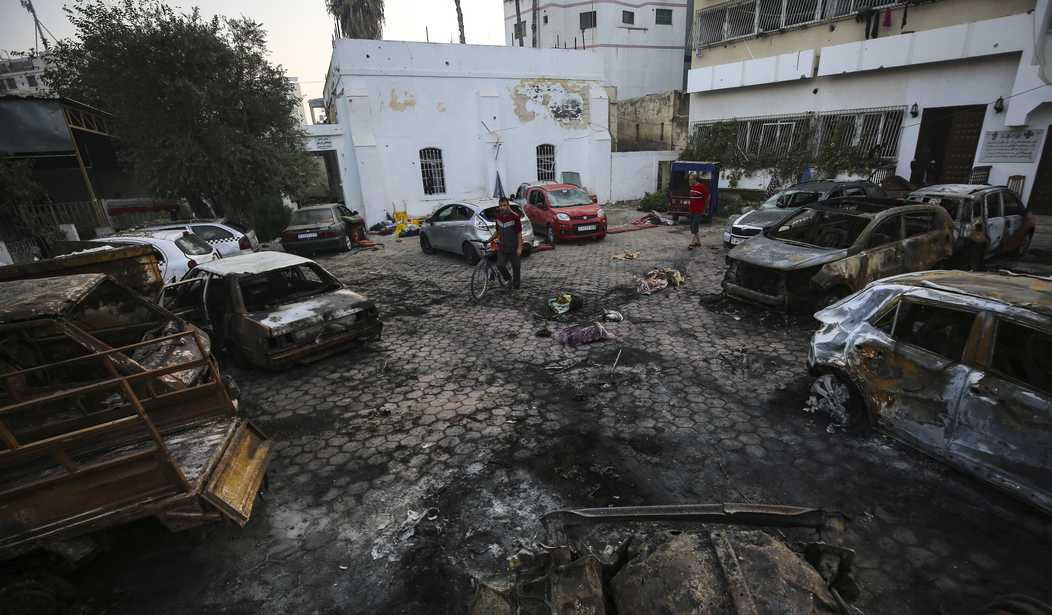Top News
CNN: Gaza Hospital Blast Caused by a Rocket, Not an Israeli Airstrike

Three days ago the BBC contacted experts at think tanks, several of whom told them that the Gaza hospital explosion was caused by a rocket not by an airstrike. But the argument over this has continued.
Channel 4 News published a story Friday based on another investigation which concluded the incoming attack came from somewhere in the east (i.e. in the direction of Israel), not from the southwest where militants were known to firing rockets at the time. In addition, this report claims an analysis of the crater at the scene also shows the object came from the east.
Human rights investigators have shared new information with Channel 4 News that they say casts doubt on some aspects of Israel’s account of the Gaza hospital explosion.@alextomo reports. pic.twitter.com/h9C02qMYLj
— Channel 4 News (@Channel4News) October 20, 2023
Does this mean the tide is turning against the conclusion that this blast was caused by a stray Palestinian rocket? Well, yesterday, CNN released the results of its own forensic investigation of the scene. Their analysis lines up with the Israeli-US explanation.
Without the ability to access the site and gather evidence from the ground, no conclusion can be definitive. But CNN’s analysis suggests that a rocket launched from within Gaza broke up midair, and that the blast at the hospital was the result of part of the rocket landing at the hospital complex.
What about the audio of the impact? Does it prove this was an Israeli missile traveling from east to west? CNN spoke to experts who said no.
Two weapons experts who reviewed the footage for CNN said that the sound in the video was not consistent with that of a high-grade military explosive, such as a bomb or shell. Both said that it was not possible to form any definitive conclusions from the audio in the clip, caveating that the mobile phone could have affected the reliability of the sound.
A leading US acoustic expert, who did not have permission to speak publicly from their university, analyzed the sound waveform from the video and concluded that, while there were changes in the sound frequency, indicating that the object was in motion, there was no directional information that could be gleaned from it.
CNN had a freelance reporter on the ground the morning after the explosion. They were able to provide images and video to 8 experts who ruled out an Israeli aircraft fired JDAM.
Marc Garlasco, a former defense intelligence analyst and UN war crimes investigator with decades of experience assessing bomb damage, said that whatever hit the hospital in Gaza was not an airstrike. “Even the smallest JDAM [joint direct attack munition] leaves a 3m crater,” he told CNN, referring to a guided air-to-ground system that is part of the Israeli weapons stockpile provided by the US.
Chris Cobb-Smith, a British weapons expert who was part of an Amnesty International team investigating weapons used by Israel during the Gaza War in 2009, told CNN the size of the crater led him to rule out a heavy, air-dropped bomb. “The type of crater that I’ve seen on the imagery so far, isn’t large enough to be the type of bomb that we’ve that we’ve seen dropped in, in the region on many occasions,” he said.
They also ruled out an airburst bomb which experts said would have done more top-down shrapnel damage to cars in the area. As for an artillery shell, the crater again seems too small.
“For a 152 / 155 mm artillery projectile with a point detonation fuz (one that initiates the explosion upon hitting the ground) I would expect a crater of about 1.5m deep and 5m wide. The crater here seems substantially smaller,” Senft said.
That rules out almost anything other than a stray Palestinian rocket. The definitive proof of who did this should have come from pieces of whatever created the blast. Those pieces are always found at the scene. For instance, I wrote about a missile strike on two Russian airfields last week and multiple pieces of US ATACMS missiles were found at the scene. They could even verify the exact date of manufacture based on pieces that were recovered.
#Ukraine: Well, something extraordinary happened- the remains of M39 missiles (Made in 1996 and 1997) of the MGM-140A ATACMS Block I system used by Ukrainian forces against Berdyansk AB.
This variant has a range of ~165km, inertial guidance, and carries 950 M74 submunitions. pic.twitter.com/AJQPC1WM2Q
— 🇺🇦 Ukraine Weapons Tracker (@UAWeapons) October 17, 2023
So it’s very strange that no pieces of whatever hit the hospital courtyard has been found. One of the experts CNN spoke with, Marc Garlasco, said in every investigation he’s done in 20 years pieces of the weapon have been found, except in this case.
There’s always a piece of a bomb after the fact. In 20 years of investigating war crimes this is the first time I haven’t seen any weapon remnants. And I’ve worked three wars in Gaza.”
— Marc Garlasco (@marcgarlasco) October 21, 2023
The implication of what he’s saying is clear. Pieces of whatever hit the courtyard were left behind. The fact that no one has seen them suggests they were removed in the night, before daylight and outside reporters arrived to view the scene. You can take this a step further and say that if the pieces found had come from an Israeli missile of some kind, Hamas would have been eager to show that evidence to the media. The fact that they didn’t and that the evidence just disappeared strongly suggests they are covering something up.
Read the full article here


















